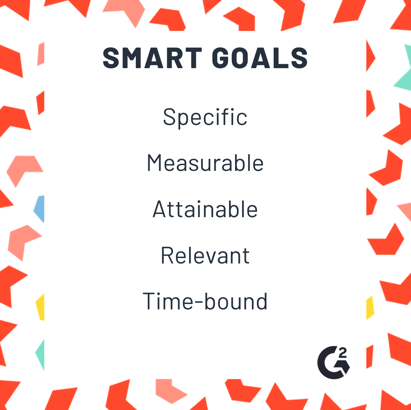Tips for leading a meeting
- Set goals before the meeting
- Create an agenda
- Invite the right people
- Present the agenda and goals
- Take notes
- Give your full attention
- Get other people involved
- Shut down other devices
- Review action items
- Open it up to questions
- Follow up
1. Set goals before the meeting
Before you even schedule a meeting, identify what you wish to accomplish by the end of it. Whether you are preparing for your team’s weekly meeting or planning a sit down with a group to discuss a specific matter, ask yourself why the meeting is being held. Not only will that help you determine if the meeting is necessary, but you will have to relay those goals to the meeting participants.
There’s no reason to have a meeting if you determine there is nothing to be accomplished. Time is precious, and interrupting the workday with an unnecessary meeting can negatively affect productivity.
Also, don’t forget to make your goals SMART.

2. Create an agenda
After the goals are set, create an agenda. Include what will be covered, who will be presenting it, and in what order. For this step, ask yourself how you will reach the goals of your meeting.
This goes for uber professional sit-downs with your boss as well as casual meetings with a friendly colleague to discuss a project you are working on together. Formality doesn’t matter. Every meeting should have an agenda.
If possible, give attendees the agenda beforehand. This way they can come to the meeting prepared with questions, comments, and concerns.
3. Invite the right people
Now that you have your goals and agenda, it’s time to make the idea of this meeting a reality. And you can’t lead an effective meeting without the right attendees.
Think about the people who need to attend your meeting. Who needs to hear what you have to say? Who will have worthy ideas to contribute? Will it require the involvement of other departments?
The topic and contents of the meeting should be applicable to every member. If someone’s attendance seems unnecessary, let them know why you think they should be included.
4. Present the goals and agenda
Alright. You are sitting in the conference room waiting for everyone to show up. People file in and they are all ready to listen.
Once they all get settled, the first thing you should do is present the goals and agenda you came up with before scheduling the meeting. Give everyone an idea of what you are going to cover. If you're remote and using a screen sharing tool, now's the time to pull up those slides and get the team involved. Conversations in meetings can sometimes get off topic, and opening with the goals and agenda will help keep people on track.
5. Take notes
As you make your way through the agenda, take notes on questions and comments that come up, especially ones that affect the overall goal of the meeting. These might be important to address in the summary you send after the meeting.
If necessary, designate one person to take notes so you can fully immerse yourself in the conversations taking place. It might be helpful for them to use a document creation software that allows you to edit and later share the notes from the meeting.
6. Give your full attention
When running a meeting, it is important that you, as the leader, give the people in the room your full attention. Shut the laptop, lock the phone, and save your internal thoughts for later. This is necessary when presenting information to the group, but also while listening to what they have to say in return.
One of the best ways to have a productive meeting is to give it your undivided attention.
7. Get other people involved
Listening to the same person talk for the entire duration of a meeting can get boring pretty fast.
It is a good idea to switch up the speaker every once in a while in a meeting. Let people present updates on the project they are leading. If your meeting includes multiple departments, let each head speak on behalf of their team.
Give each new topic a fresh voice to help keep listeners engaged.
8. Shut down other devices
When leading a meeting, close and lock up your phone, laptop, tablet, or whatever else you use to work. It can be tempting to work on other things if a meeting’s contents are getting a little dry, but listening and paying attention is everybody’s responsibility, no matter their role.
9. Review action items
Even after you’ve touched on everything that needed to be covered in the meeting, it still needs to be wrapped up somehow.
Along with key takeaways, the best way to conclude a meeting is by stating action items. If there is anything that the attendees need to do after the meeting, tell them in as straightforward a way as possible with a timeframe for completion.
10. Open it up to questions
Feedback is the backbone of effective communication. And a team meeting needs effective communication to be worthwhile.
After you’ve made the action items clear, open the floor to questions. Participants might have questions about the action items or anything else that was covered in the meeting. Make it clear that there are no dumb questions and that they can be about anything discussed in the meeting, not just what was covered last.
Some questions might come up at random points throughout the meeting. No problem. Just make sure you end the meeting by asking if anyone has anything else they would like to ask.
This doesn’t need to be a big deal. Maybe just add a slide at the end of the meeting presentation. Here is the simple G2 questions slide with our mascot, Monty the Mongoose.

11. Follow up
Alright, the meeting is over. You did it! However, you aren’t done yet.
The last thing you need to do when you lead a meeting is follow up with the participants. Even if you clearly go over the action items at the end of the meeting, it can’t hurt for everyone to get it in writing.
On top of those action items, include the key takeaways from the meeting in your follow up. Reiterate lessons learned, points made, and new ideas that sprouted from the conversation.
Make your meetings meaningful
Learning how to lead a meeting isn’t easy. It requires organization, preparation, and focus. It can be challenging at first, but with time and the tips listed above, you can become an expert meeting leader.
Adapted from an article by Mary Novak on Learn Hub
